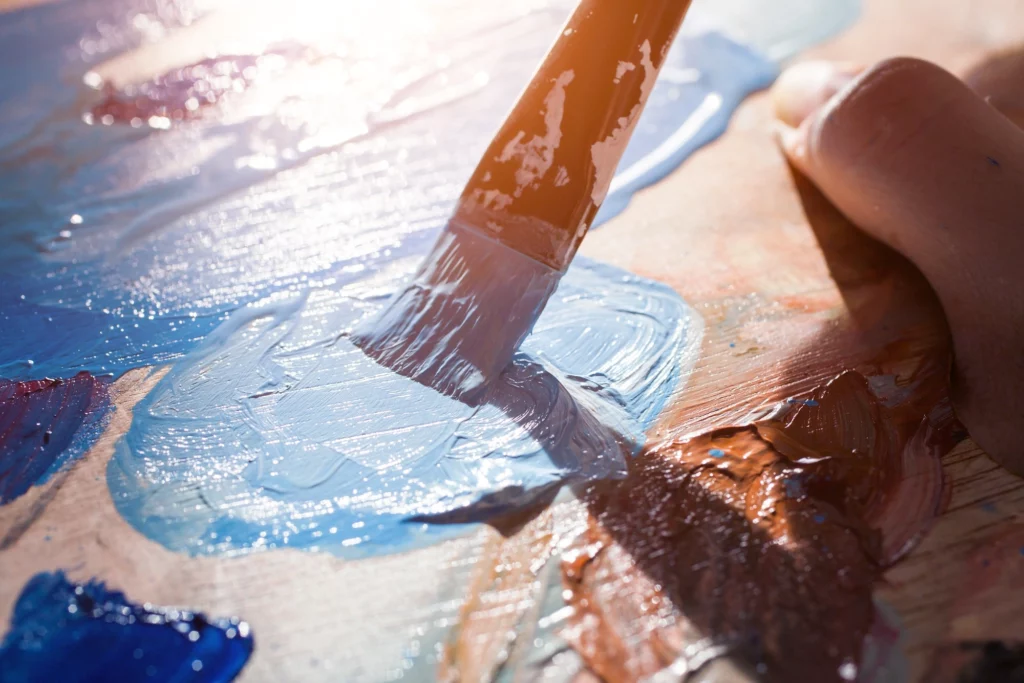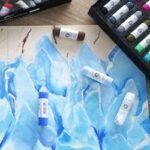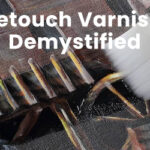Specialty Paints – What Kind of Paint Should I Use: Part 2
Adventures in alternative painting mediums!

Specialty Paints
Part 2: What Kind of Paint Should I Use
Previously, when discussing in Part 1 of which paint to use, we dealt with the top three mediums most popular in painting today: oil paints, acrylics, and watercolors.
However, there are so many more to choose from! Painting was around for thousands of years before modern paints were, and while the most basic — as on cave walls — is simple pigment mixed with a binder — people were using advanced and beautiful paints long before even oil colors were developed.
Sometimes we forget that today’s most popular paints are, comparatively, brand new. Acrylics were only invented in the mid-20th century; modern “moist” watercolors arose in the 19th century; and even oil paints were a new option when Leonardo da Vinci was painting during the Renaissance.
What, you ask, were people painting with before?
Well, put on your fedora and pick up your whip, Indiana, because we’re about to set off on a crusade through classical paint mediums — and their modern incarnations!
Encaustic Paints
Encaustic paints get their name from the Greek word enkaustikos, meaning “burn with fire,” and are, in the most basic definition, paint made of hot, melted wax. Of course, there’s more to it than that — you can’t just dump a candle on a canvas and come away with an encaustic painting!
The encaustic medium is a special blend of damar resin dissolved in turpentine and blended with pure beeswax. The damar gives the wax strength and permanence — and when mixed with beeswax, smells really good!
To paint with encaustic, it must first be melted: in the olden days, this was a difficult and slightly dangerous operation, involving braziers of fire and heating tools in ovens. However, the effort was worth it: encaustic paintings that are thousands of years old are still today vibrant and beautiful. The most famous of these are known as the Fayum portraits: images painted during Egypt’s Greek-ruled period that still look fresh today.
Luckily, today we no longer have to sweat and slave surrounded by fire to paint with encaustic: we have electricity! You can use a heated palette with special palette pans to keep your encaustic melted and to heat your tools, or even an old electric pancake griddle and some empty tin cans (though, be sure not to make pancakes on the griddle any more!).
Select and melt your colors, and use just about anything to apply them to a firm, rigid surface: brushes, metal tools, and the like work well, as does straight pouring. Each layer of paint should be reheated slightly so that it bonds well with the previous layer; this is called fusing. Encaustic is also great for imbedding objects and images, as well as image transfer. T
he modern possibilities are limitless! However, for the nervous, a class in beginning encaustics is recommended.
Notable Encaustic Artists: Robert Delauney, Diego Rivera, and Jasper Johns.
Recommended Encaustic Products:
|
PAINTS |
TOOLS | SURFACES |
Egg Tempera

Egg tempera is a beautiful and unique painting medium that has been around for centuries or even longer. Now, don’t confuse egg tempera with that chalky paint you used to use in elementary school — there is no connection between the two! Egg tempera, in its most basic form, is pure pigment blended (very carefully) with egg yolk and purified water. As such, it is extremely brilliant, extremely fast-drying, and prone to becoming extremely stinky if left out too long.
Before oil paints, egg tempera was the choice of fine artists. Not only were many religious icons painted in these jewel-like colors, famous artists such as Botticelli spent their entire careers painting in little else. Painting with egg tempera is unlike any other medium: because it dries almost immediately after hitting the board, the egg tempera painter must use very small, overlapping hatch marks to build up color in multiple layers. It requires patience and meticulous attention to detail, but because of the composition of the paint and the egg yolk, yields a stunning depth and almost inner glow as light bounces and refracts through the multiple layers of paint.

Back in the day, artists had to mix their egg tempera by hand, every day, since the egg would turn rancid quite quickly and didn’t keep well. Nowadays, however, we have pre-mixed egg tempera paints which include preservatives, and are ready to use straight out of the tube! (This is the perfect option for more lazy artists like myself.) However, unlike most other modern paints, we still have to pay very close attention to our painting surfaces, since egg tempera doesn’t like to stick to much at all, and is very brittle. This means the ideal painting surface for egg tempera is rigid board or panel, coated in traditional rabbit skin glue size and chalk gesso. But yet again, modernity saves us: Ampersand’s Claybord is one of the very few surfaces that are perfect for use with egg tempera and require no preparation whatsoever!
Notable Egg Tempera Artists: Sandro Botticelli, Andrew Wyeth, and Koo Schadler.

Recommended Egg Tempera Products:
|
PAINTS |
TOOLS |
SURFACES |
Casein

Casein paint is, like encaustic and egg tempera, an ancient painting medium made from materials that ancient painters had close at hand: in this case, milk protein (similar to curds) and an alkali (like modern Borax). However, unlike the other two paints on our crusade, casein is a complete shapeshifter as it were, and can be made to mimic other mediums from watercolors to oils.

Casein is water-mixable, and as such, can be thinned down to transparent washes akin to watercolor, or also used in heavier, impasto-like layers that can be mistaken for oils. If you’re looking for a versatile, natural paint that also has an easy clean-up, casein is your answer! Its drying time is fairly quick, but casein paintings can take a few months to cure completely: though once they are, they are totally water-resistant and just as permanent as oil colors.
Throughout the centuries, casein has been used in virtually every application from ancient Chinese artifacts, to stage and poster painting, to house paints and advertisement illustrations. In the modern day, casein is seen as a “green,” eco-friendly paint that can behave like acrylics or oils, but without any of the plastics or solvents needed in those mediums. And of course, we no longer have to make our own: pre-mixed casein is readily available for experimentation!
Notable Casein Artists: Henri Matisse, Ramon Shiva, and Andy Warhol.

Recommended Casein Products:
|
PAINTS |
TOOLS |
SURFACES |
So there you go! The world of painting mediums a bit bigger than you previously thought? A lot of artists are moving back towards these more traditional paints, attracted by their history, their eco-friendly qualities, and the ease of use given by modern amenities that was formerly unavailable. As always, the only way to know which of these alternative paints is right for you is to experiment and have fun!






